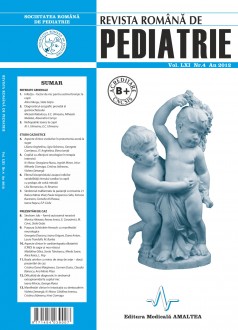SELECT ISSUE

Indexed

| |

|
|
|
| |
|
|
|

|
|
|
|
|
|
|
HIGHLIGHTS
National Awards “Science and Research”
NEW! RJP has announced the annually National Award for "Science and Research" for the best scientific articles published throughout the year in the official journal.
Read the Recommendations for the Conduct, Reporting, Editing, and Publication of Scholarly work in Medical Journals.
The published medical research literature is a global public good. Medical journal editors have a social responsibility to promote global health by publishing, whenever possible, research that furthers health worldwide.
Diagnosis difficulties in extrapyramidal syndrome in young children
ABSTRACT
Introduction. Lesch-Nyhan disease is a genetic disorder, X-linked recessive, of the purines metabolism, characterized by deficiency of hipoxanthine-guanine-phosphoribosyltransferase (HPRT- 1) which results in an increase of uric acid in both the blood and the urine. The gene is located on the chromosome X q26- q27.2.
Case presentation. It’s presented the case of a boy now 6 years old, with multiple admissions in Pediatric Neurology Clinic, “Al. Obregia” Hospital from the age of about 1 year for psychomotor developmental delay, movement disorders, initially diagnosed with cerebral palsy, then at the age of 3 years old, once the selfmutilation behavior and hyperuricaemia were noticed we suspected Lesch-Nyhan disease which was genetically confirmed at the age of 3 years and 6 months.
Conclusions. A clinical picture of spastic-dyskinetic “Cerebral Palsy” with normal cerebral MRI can underlay a metabolic disorder with genetic transmission and increased risk of recurrence.
Key words: extra-pyramidal syndrome, hyperuricaemia, HPRT gene
